
Can I eat it? Will it harm me? These are the two basic questions the forager needs to answer when looking at any potentially edible plant. Once we decide to view the wild herbs, trees, mushrooms, seaweed and seafood of this country as a possible source of food, we enter a world, not only brimming with exquisite and unusual flavours, textures and aromas, but also pitted with numerous hazards and even the vague possibility of a hideous death! Is it all worth it just for a plate of food…if approached sensibly then the answer if definitely yes. Approach this topic with too casual an attitude and the results may be very unpleasant. So, that’s the melodrama out of the way, now down to the simple bit….Foraging is easy if you learn how to answer the two opening questions and the easiest way to do this is to Divide and Conquer (though not in the traditional sense). Dividing plants into their separate families ie the mint family, cabbage family, carrot family, allows us to learn group characteristics (square or round stems, number and colour of petals, different leaf shapes, common smells, habitats etc etc) and this in turn allows us to “half way” identify numerous plants very quickly, at least to be able to put them in the right family. This is a very good start on the road to correctly ID’ing a plant and lets us know how we can proceed, depending on whether we have entered a family full of potential dangers or one with very few. Imagine walking into you local pub, hopefully it contains your friends, some people who like you and maybe a few who don’t, but at least you know the protocol and can feel relatively at ease…this is the mint family.
Now lets go to that dodgy looking bar on the other side of town. This is the carrot family, full of dangers, full of delights and possible excitement but whatever comes along it’s the sort of place where we really need to tread carefully. In the same way, once we can positively identify the plant family we are looking at, we can adapt our behaviour accordingly. Here’s a few of the most common plant families that our wild foods come from and a suggestion of how we should treat each one.
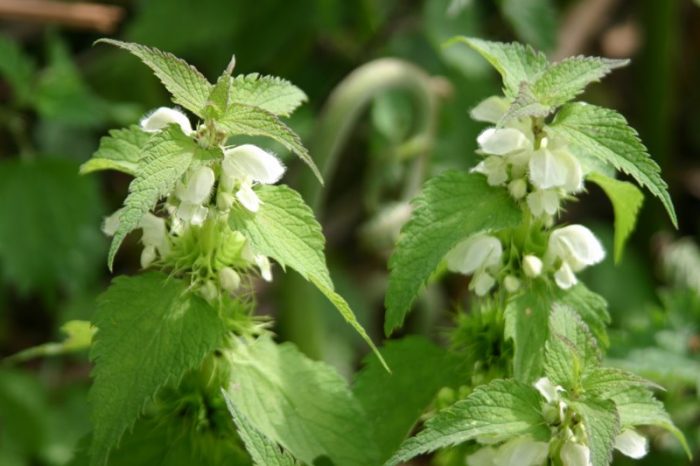 The Mint or Dead Nettle Family. Bar one, there are no poisonous members of this family in the UK although a few that might taste horrid or give you a slight stomach ache. A great place to start learning.
The Mint or Dead Nettle Family. Bar one, there are no poisonous members of this family in the UK although a few that might taste horrid or give you a slight stomach ache. A great place to start learning.
The Rose Family. Almost all of our tree fruit and soft fruits come from this huge plant family with only a couple of toxic plants to avoid.
The Cabbage Family. Numerous edible plants, none poisonous and a couple that taste pretty horrid. A safe place to learn.
The Carrot Family. Some deadly members like Hemlock and some very tasty ones. Extreme caution is needed here. Not for beginners.
The Pea Family. Numerous edibles and a few poisonous members to be learnt and avoided.
The Daisy Family. Another huge group of plants, many edible, only a few toxic and some inedible.
The Potato Family. Dangerous members include Deadly Nightshade and various other extremely toxic plants.
The Buttercup Family. A few edible and numerous poisonous plants.
The Lily/Amaryllis Family. Contains numerous tasty wild garlics and onions but also plenty of poisonous lilies. Careful study needed but great rewards on offer.
Other popular plant families with foragers include The Poppy Family, The Goosefoot Family (wild spinaches), The Primrose family and The Willow Herb Family.
MY FIRST TOP TIP.
I find the best way to learn is to concentrate on one family at a time; that’s not to say it’s not as rewarding and educational to just try and ID whatever you come across, I just find the repeat observation of similar characteristics is an excellent way to absorb information and in addition it pays dividends to look at the same plant or plants at all times of their life cycle, through out the year.
MY SECOND TOP TIP.
Bear in mind that often we want to use (eat) a plant when some of its key ID features may not be on show ie its flowers, or we may want to return to it to dig up its roots when there is very little of it left above ground, so being able to positively locate a plant by previously gathered information, is very useful. I often refer to this as learning the plant backwards; making a 100% positive ID when all the best information is on show, then revisiting it in all its stages in the safe knowledge that you know what it is.
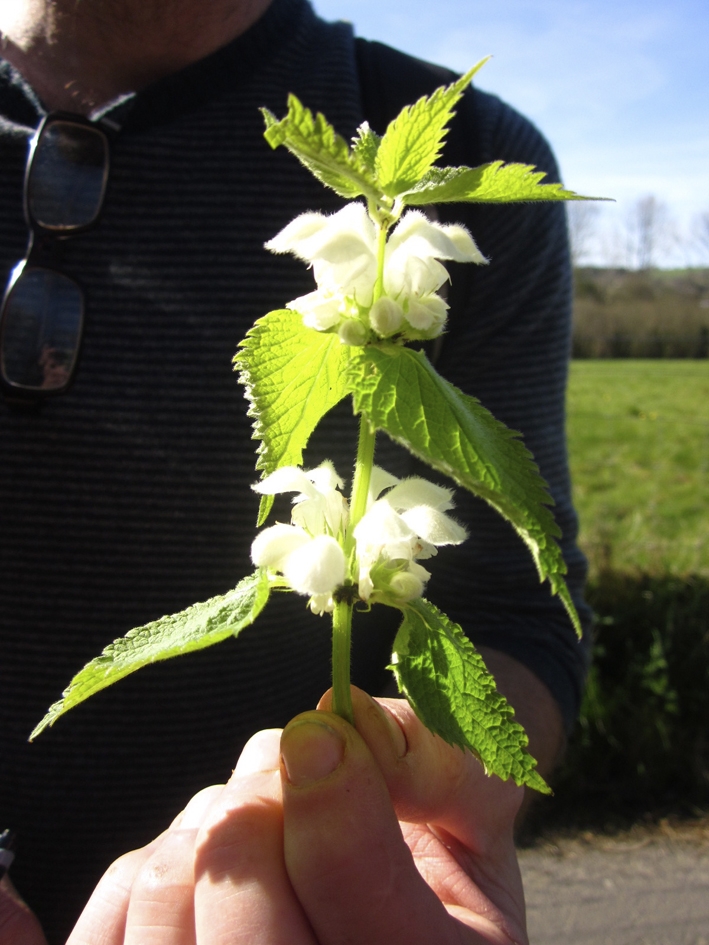
So, I promised 50 plants in less than 10 minutes. Ready, steady…..Go! Welcome to The Mint/Dead Nettle Family or to give it its Latin name, The Lamiaceae (formerly Labiatae) Family. This family not only contains numerous tasty wild herbs with great names like Penny Royal and Bastard Balm, but also many of our most common domestic ones…Thyme, Basil, Sage, Rosemary, Lavender, Marjoram and of course Mint. The only poisonous plant here is called Bugle (Ajuga reptans) and should be easy to spot/avoid with its dark green leaves and dark blue flowers (for more info click the link at the end). This family has plenty of easy features to help with identification but what do they all have in common? Well, a few things but maybe most obviously…….
1. SMELL. Does it smell like mint? Chances are that it is. Most, but not all, members of this group have quite strong, usually pleasant, occasionally unpleasant, smells. That’s not to say that other plant families don’t also have some strong smells but The Mint Family has a few quite commonly reoccurring smells that will help you to narrow down your search. Smell is best used in tandem with some of the slightly more specific characteristics below but is often the only guide you need.
2.STEM SHAPE. All members of this family have square stems. Get the stem between you thumb and forefinger and roll it. Each side has a flattish surface to it. This is an excellent ID feature but as with smell, it doesn’t mean you are definitely in the right family as there are other plant families with square stems. We will look at these in a minute and how to very easily, as the police say, “eliminate them from our enquiries”.
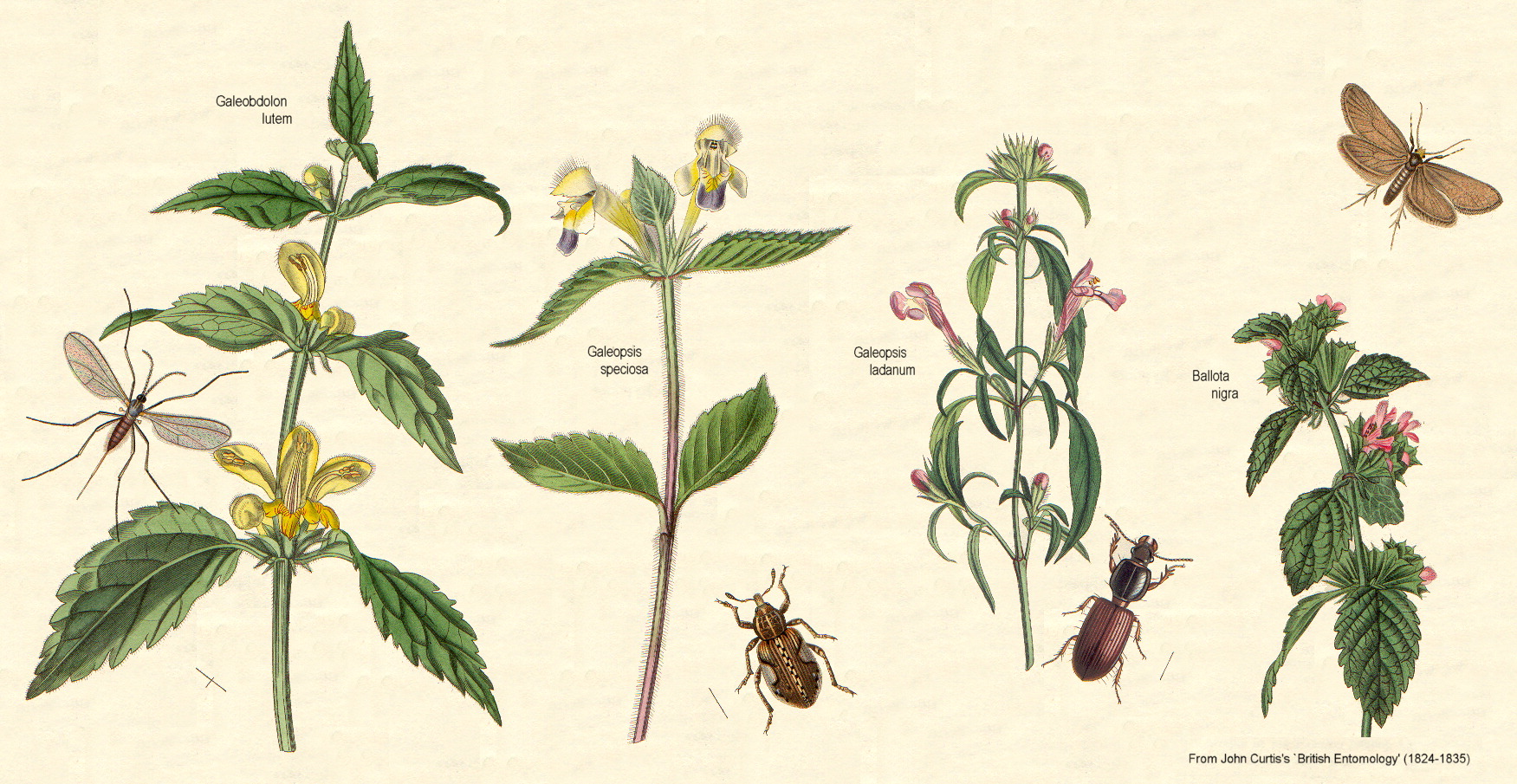 3. LEAF ARRANGEMENT. All members of this family have leaves in opposite and opposing pairs. In other words, there will be two leaves exactly opposite each other on either side of the stem, making a pair, further up the stem there will be another two leaves at 90% to the previous set, and so on all the way up the stem ( this arrangement is called Decussate). Get some mint from the garden or the shop and have a look at this as well as the square stems. Numerous members of this family also have leaves with the similar pointed shape and cerated edges found on many nettles and mints. Not all do, but this is also a good indicator. Stinging Nettles are not in this family and although they have decussate leaves and appear similar, the stems are rounded and ridged, not square.
3. LEAF ARRANGEMENT. All members of this family have leaves in opposite and opposing pairs. In other words, there will be two leaves exactly opposite each other on either side of the stem, making a pair, further up the stem there will be another two leaves at 90% to the previous set, and so on all the way up the stem ( this arrangement is called Decussate). Get some mint from the garden or the shop and have a look at this as well as the square stems. Numerous members of this family also have leaves with the similar pointed shape and cerated edges found on many nettles and mints. Not all do, but this is also a good indicator. Stinging Nettles are not in this family and although they have decussate leaves and appear similar, the stems are rounded and ridged, not square.
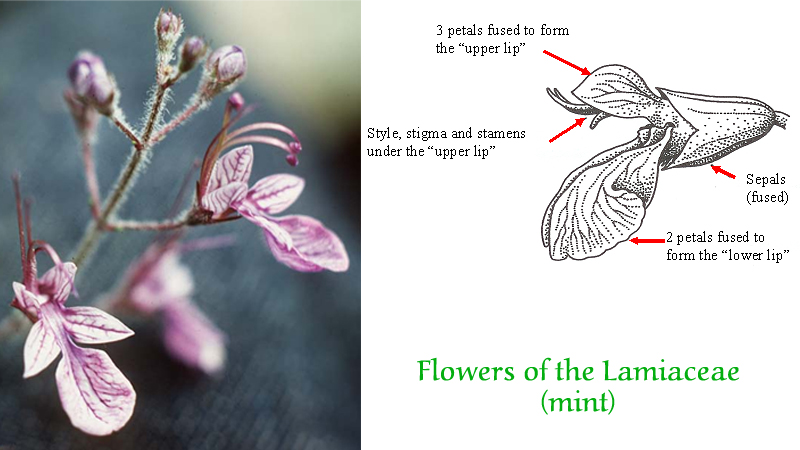
4. FLOWERS. Using flowers for ID purposes is a bit of a luxury for the forager and also often means the plant is well past its best (think how bitter many cabbage like plants are when they have flowered or “gone over”). The old name for this family, Labiatae, comes from the Latin word Labium meaning lip and refers to the two lobed/fused bottom petals of many of the flowers in this family. All flowers in this group have five petals that are fused together to create various united tube shapes and although as foragers, we want to avoid too much botany, it’s worth mentioning that these flowers occur in various arrangements, many growing straight from the main stem (with no separate flower stems), like Spearmint, and some growing in multiple layers above the rest of the plant, like Lavender. Numerous colours are also found so this is not useful for general Family ID but getting to recognise the sorts of flowers present in this family is easy and also useful.
5. AVOIDING OTHER SIMILAR FAMILIES. I say similar but almost all of these bear little to no resemblance to members of The Mint Family. Once we have an idea that we are in the right family, which using just the first 3 of the methods above (to recap, that’s 1.smell 2.square stems 3.decussate leaves), will take only a matter of seconds, it then requires a good ID book to help eliminate the other suspects. With a little practise this not only becomes very easy but also helps us to start learning new plant families. I use The Wild Flower Key by Francis Rose but there are many other good guides available and it’s good practise to use 2 or 3 separate books to cross reference (at home, not out and about….that just looks too nerdy). The possible lookalikes to avoid are :
The Vervain Family. With square stems and decussate leaves, this is almost in The Mint Family, but with only one wild UK species, this should be pretty easy to ID with a good guide book.
The Purple Loosestrife Family. Also just the one plant in this family in the UK (ok two, but one grows in water). Stems and leaves similar to the mints but very different flowers.
The St. Johns Wort Family. A couple with square stems and all with opposite/opposing leaves. Can look similar to young wild marjoram but without the obvious smell these are easy to eliminate. Very different flowers too.
The Figwort Family. Half a dozen with square stems and Decussate leaf arrangement but very different flowers, or if they are similar looking they will have 3 bottom lobes not 2. A good ID book will help you pick these few up easily.
OK, STOP THE CLOCK. We can now reliably identify the approximately 50 members of The Mint Family we have in the UK. At this stage, we are pretty much equipped with all the information we need to safely try a bit of the plant in question, happy in the knowledge that it belongs to the right group, but it pays to only ever consume a tiny amount of any new food to be sure there is no adverse reaction, allergic or otherwise. Even the toxic Bugle mentioned earlier (and pictured below) has edible leaves and young shoots (but with reports of its narcotic effects, any more than a nibble is probably not a good idea). No other UK members of this family are poisonous but some wouldn’t make it into a salad. Unlike most of what I write, this blog isn’t really about the uses of the the plants so I won’t at this stage, go into cooking, eating, medicinal uses etc. I would suggest though, that rather than just having a nibble, it’s very important to carry on to the final stages of ID below.

6. HABITAT. It helps to become familiar with different habitats but this will come with time. This group of plants grow in an enormously varied range of environments and being perennial and often very hardy, can tolerate all sorts of conditions. Water Mint is a great example of how habitat can help us specifically ID a plant. Does is look like mint? Does it smell like mint? Does it have the key ID features? Is it in or very close to water? Chances are it’s Water Mint. Easy.
7. FINE TUNING YOUR ID. Using a good guide, decent photos or illustrations and more specific details, we can then put a plant into Genus (a smaller group within the family) and then into species. This is the final stage of ID which would be written like this: Mentha aquatica (water mint), Mentha describing the genus and aquatica, the species.
Just for the record, these plant families also have square stems but I really don’t consider them lookalikes.
The Bedstraw Family. Also have square stems, but their leaves occur in groups of 4-8 in wheels ( called whorls) around the stem. They also have flowers with 4 separate petals.
The Borage Family. A few with square stems but the leaves are not opposite and opposing.
The Willow Herb Family. Two or three with square stems but not opposite, opposing leaves.
Next month I will probably do a similar exercise with another plant family, possibly The Cabbage Family or maybe one with a few more poisonous members. As a foot note, the oil made from Penny Royal (Mentha pulegium) is extremely toxic but the plant in its unprocessed sate it is not, but still probably best avoided. Here are a few botanical drawings to remind you of some of the key features we have looked at. Although the title of this blog is rather flippant I hope you can see that I take the topic pretty seriously and endeavour to offer only sound advice which I hope gets used sensibly and brings you much, safe enjoyment .Happy hunting.
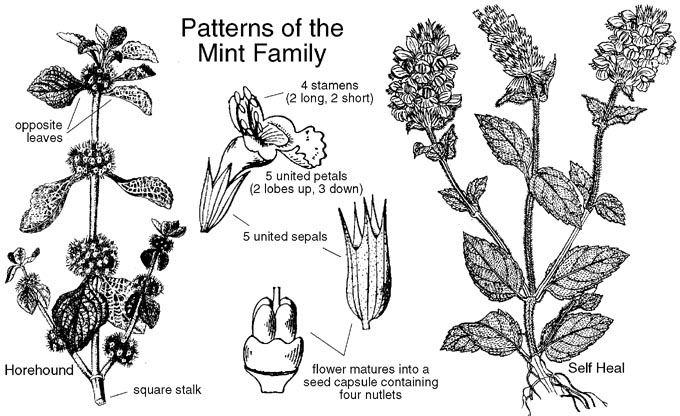
“Illustration used with permission of Thomas J. Elpel, author of Botany in a Day.”

Sound advice, John. I have been photographing plants now that I am not sure what they are so that I can return when they are in flower to firm things up, and I have the photo to remind me in a year’s time what they are.
One other plant with square stem and paired leaves is purple loosestrife, I thought that was mint family before I learnt better.
thanks lee, good idea to do that, and thanks for the purple loosestrife comment, will add it to the blog… i knew there was at least one missing but couldn’t think…i think the principles are sound though, all the best john
Thanks very much for your information, very useful and just what I’m into. Last summer in Cornwall I was juicing nettles, plantain and sticky jack from my garden along with beetroot, carrot etc. If you do any info walks etc let me know. Good work!
thanks Penny, I have some walks in dorset but nothing as far over as you are..happy hunting
love it.. as a beginner botanist and a salad eater it’s really helpful and fun… thank you
thanks Sekeeta,happy hunting
Bugleweed is non toxic to humans, why are you saying it is poisonous?
At the time of writing this about a decade ago, there was some questionable research so because this was a beginners blog and I didn’t want to go off on a tangent I marked it toxic. Honestly, I can’t remember and probably need to do some more reading, but I seem to remember they’re being something about a narcotic like substance being produced from the oil. Sounds like nonsense now I think about it.
That opening line captures the forager’s dilemma so well – excitement and danger in equal measure. I like how the comparison of plant families to familiar places, like a safe pub versus a dodgy bar, makes the science less intimidating and much easier to visualise.
It reminded me of why learning the families matters more than memorising individual species. Once you see the patterns, the landscape suddenly feels less chaotic and more like a map you can read. Coeur Sauvage (https://coeursauvage.scot/) often leans into this way of thinking: build confidence step by step, start with the safe families, and only then edge toward the trickier ones.